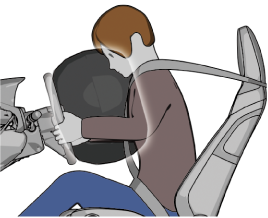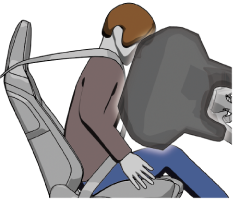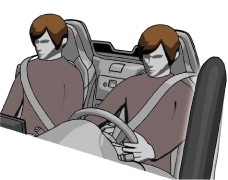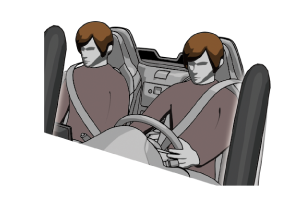

SRS Air Bags
If the vehicle receives a strong impact from the front or side of the vehicle when the vehicle power is switched ON, the air bags inflate instantaneously and lessen the impact on the head or chest of the driver or passenger.
The SRS air bag system protects occupants together with the seat belts and they are not a substitute for the seat belts.
There are 3 types of air bags.
Vehicles have a sensor which detects an impending roll-over accident.
The air bag supplemental restraint systems are designed to provide supplemental protection in certain situations so seat belts are always important.
Without seat belt usage, the air bags cannot provide adequate protection during an accident. Seat belt usage is necessary to:
-
Keep the occupant from being thrown into an inflating air bag.
-
Reduce the possibility of injuries during an accident that is not designed for air bag inflation, such as rear impact.
-
Reduce the possibility of injuries in frontal, near frontal or side collisions or roll-over accidents that are not severe enough to activate the air bags.
-
Reduce the possibility of being thrown from your vehicle.
-
Reduce the possibility of injuries to lower body and legs during an accident because the air bags provide no protection to these parts of the body.
-
Hold the driver in a position which allows better control of the vehicle.
Driver's air bag
The driver's air bag is stored in the center of the steering wheel.
When air bag crash sensors detect a frontal impact of greater than moderate force, the driver's air bag inflates quickly helping to reduce injury mainly to the driver's head or chest caused by directly hitting the steering wheel.
(Except Mexico)
The driver's dual-stage air bag controls air bag inflation in two energy stages. During an impact of moderate severity, the driver's air bag deploys with lesser energy, whereas during more severe impacts, it deploys with more energy.

Passenger's air bag
The passenger's air bag is stored in the dashboard.
The inflation mechanism for the passenger air bag is the same as the driver's air bag.
In addition, the passenger air bag is designed to only deploy when the passenger occupant classification sensor detects a passenger sitting on the passenger's seat.

Side air bags
The side air bags are installed in the outboard sides of the seatbacks.
When the air bag crash sensors detect a side impact of greater than moderate force, the system inflates the side air bag only on the side in which the vehicle was hit. The side air bag inflates quickly to reduce injury to the driver or passenger's head and chest caused by directly hitting interior parts such as a door or window.
In addition, the passenger side air bag is designed to only deploy when the passenger occupant classification sensor detects a passenger sitting on the passenger's seat.

In a roll-over:
In response to a vehicle roll-over, both side bags inflate.

Both side air bags will deploy after the roll-over accident is detected.
Constant Monitoring
The following components of the air bag systems are monitored by a diagnostic system:
-
Air bag sensors
-
Crash sensors, and diagnostic module (SAS unit)
-
Side crash sensors
-
Air bag modules
-
Seat belt pretensioners
-
Air bag/Seat belt pretensioner system warning light
-
Related wiring
-
Passenger occupant classification sensor
-
Passenger occupant classification module
-
Passenger air bag deactivation indicator light
The diagnostic module continuously monitors the system's readiness. This begins when the ignition is switched ON and continues while the vehicle is being driven.
